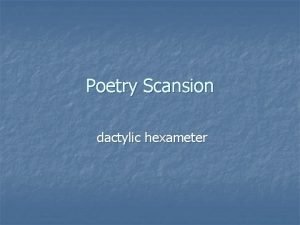The Humanistic Elysium of Elegiac Poets Cristoforo Landino

- Slides: 1

The Humanistic Elysium of Elegiac Poets (Cristoforo Landino and Giovanni Pontano) Grażyna Urban-Godziek ON-LINE: II Simposi Internacional Delits prohibits: sexe, erotisme, bellesa, estètica, gaudi, dret, pecat i prohibició. Un esguard segons els clàssics, l'etnopòetica, la història i la lingüística de corpus II Simposio Internacional Placeres prohibidos: sexo, erotismo, belleza, estética, disfrute, derecho, pecado y prohibición. Una mirada desde los clásicos, la etnopoética, la historia y la lingüística de corpus 2 nd International Symposium Forbidden Delights: Sex, Eroticism, Beauty, Aesthetics, Pleasure, Law, Sin and Prohibition: A look from the Classics, Ethnopoetics, History and Corpus Linguistics. Data: 19 -20 de juny. Horari: divendres, de 16 -21 hs; dissabte, de 9 -14 hs. Lloc de realització: Seu Universitària de la Nucia. ***** th 14 INTERNATIONAL SYMPOSIUM NEW TRENDS IN R+D+I IN LITERATURE, LANGUAGE, EDUCATION AND IST. FROM INNOVATION TO CANON Classical tradition A vision of eternal happiness in the Underworld, on Elysian Fields or the Fortunate Islands, given to people who were not enough happy in their lifetime, originally was a strictly epic, heroic motif. The promise of eternal award could encourage soldiers to risk their life. Even primary it was designed only for the heroes from the Cronos Race (in Odyssey 4. 560 -569 and Works and Days 156 -169 b), though later it came to the encomiastic literature (Pindaric Olympian Ode II) and to the patriotic narration of Vergil’s Aeneid, where the Campi Elisei were prepared for those who died for the fatherland. But Vergil, combining the Greek epic tradition with philosophical Pythagorean-orphic and Platonic, invites to the Elysian Fields also those who belong to Apollo, people such as priests, pious prophets (pii vates), and men who ennobled their lives with the search for truth, earning a place in human memory. In the context of later verses we can assert that he means the epic poets. Those verses from the sixth book of Aeneid must have been known by Tibullus (I 3) and Propertius (IV 7) when they started to create their elegiac underworld. In the elegy I 3, written in expectation of impending death, Tibullus preparing his epitaph starts dreaming about a consolation in the afterlife, seeing his place in the Elysian Fields of Hades. This image does not differ much from a typical picture of Elysium or Isles of the Blest. The fragrant meadows with roses and even myrtle (an attribute of Venus), birds singing and happy souls dancing appear in most of such descriptions. What distinguishes Tibullus, it is the elegiac vocabulary depicting Elysian happiness. The inhabitants of this happy realm are depicted with the adjectives peculiarly connected with the elegiac kind of love: tenuis, and tener. Their activities seem to be presented according to the same convention: “Ac iuvenum series teneris inmixta puellis / ludit, et adsidue proelia miscet Amor” (64 -65). The verb ludo, in the elegiac vocabulary commonly denotes “play” of a sexual nature. Whereas proelia – permanent battles stirred up by Amor refers to one of the most important elegiac topoi, i. e. militia amoris. In such a manner settled the elegiac Elysium for faithful lovers, has been later developed in Ovid’s elegy III 9 – the famous epicedium for Tibullus, which is in fact a parody of the oldest elegiac. According to Ovid, in the depth of Hades Tibullus is to join the company of his friends, the elegiac poets: Calvus, Catullus, and Gallus. (We can discern the inspiration of Plato, Vergil, as well as Epitaphium Bionis here, and in fact it is a variant of the dialogues of dead). Also the other Ovidian elegy shows the postmortal delights of “poets”, metaphorically presented as birds, in the mourning elegy for Corinna’s death parrot (Am. II 6). The Humanistic Elysium of Elegiac Poets Adapting the genre of Roman love elegy, the humanists of the High Renaissance exploited the motif of Elysium prepared especially for elegiac poets, poets of love. Let us consider examples of maybe the greatest poets of these times: Cristoforo Landino and Giovanni Pontano. In his Eulogium in Carolum Arretinum (Xandra, III 7) Landino praises Carlo Marsuppini d’Arezzo. The great humanist and the translator of Homer is mourned by Kaliope herself, and taken to Elysian Fields. He finds himself in the ‘circle’ of learned poets (vv. 169– 210), which is divided into national regions: Egyptian, Persian, Babylonian, Greek, Roman, and Etruscan. The delights of the last, i. e. the Florentine underground region, are described widely (vv. 179 -196), and modelled on Tibullus. First, the authors of heroic verses: Dante and Petrarch are referred to periphrastically, and then they are followed by another two great Florentines: Boccaccio, and Leonadro. It is Marsuppini who joins them now. That said, we must remember of the other important sources that contributed to Landino’s as well as Pontano’s creation of Elysian Fields. Those are the above mentioned late-Medieval authors of epics: La Divina Commedia and Africa. Thus, following Vergil’s Campi Elysei Dante created Limbo with la bella scuola – a circle of the greatest poets (de l’altissimo canto), where Homer, Horace, Ovid and Lucan were together. In the other part of Limbo, in the nobile castello, where prato di fresca verdure is located, a crowd of magnanimi dwell together: poets, thinkers, politicians and mythical heroes. Whilst Petrarch, in his epics devoted to Scipio Africanis, entered a vision of Elysium which would join two lovers, now cruelly separated by the death sentence given to Sophonisba. Massynissa consoles themselves with imagination of his dear wife waiting for him in Elysian Meadows. This beautiful, long lamentation of a men crying on his dear lady dying, was willingly followed by humanists. Pontano certainly was one who inherited this tradition. In his works we can find several examples of using the Elysium motif, mainly in two variants: commemorating his deceased friends (mainly in the Tumuli volumes), and trying to console himself after the premature death of his beloved wife, Adriana. In both types he painted Elysian Meadows with the colours rather of elegiac love then heroic epics. Michele Marullo, Pontano’s close friend, as Pontano himself was a politician and courtier of the Neapolitan Aragon’s royal chancery of Alfonso Magnanimous, but he is mainly remembered as the marvellous poet and humanist. His sudden death in the waters of Cecina caused a shock to Marullo’s wife and friends. Pontano constructed a tumulus for him (I 14 Tumulus Marulli poetae) but, as we read, an empty one. There is simply a name on the grave, while Michele himself is playing cheerfully in Elysian groves, having eternal otium, and being accompanied by beautiful girls dancing to lute music. At the head of the dance procession, we can see the Roman elegiac’s heroines: Corinna, Delia, Cynthia, and Catullus’s Lesbia. “It was not Parcae who took Marullus, but Muses” in order to have their lover in their embraces constantly. As an inventor of married-love elegiac poetry (cf. his De amore coniugali libri III), Pontano designed also Elysian Meadows prepared for married couples, first separated by death and then connected by it. Tumulus Laurae Arceliae uxoris Antonii Panhormitae (Tum. II 34) is based on the idea that Laura has just died and joined her previously deceased husband in Elysian happiness. Antonio Beccadelli, a counsellor of king Alfoso, Pontano’s and Marullus’ mentor, a pioneer of humanistic love-poetry, and founder of Academia Antoniana inherited then by Pontano, particularly deserved eternal dwelling on Elysian Fields described in elegiac stylistics. Finally, Laura can keep him company and the bounds of marriage, broken by Antonio’s death, now can be restored, and their marriage bed be in use again. But the full development of the motif can be found in Pontano’s lyrics addressed to his own wife Adriana (in poetry referred to as Ariadna). According to Petrarch’s idea of continuing writing love lyrics even to a deceased beauty, the Neapolitan poet followed also his conceit of meeting the beloved one in dreams, as well as the final consolation in the eternal abode. However not Christian, but a Classical one. A consolatory vision of their common rejoice in Elysium is repeated in several Pontano’s verses. The poet who outlived many of his friends and family members could hardly endure his “orphanhood” and awaited his own end. Among his Tumuli, there a few written for himself. In Tumulus Ioannis Ioviani Pontani (II 62), the underground abode prepared for him is full of music performed by nymphs dancing on gentle meadows. And among them his dearest wife. Another elegy is worth mentioning here: Ariadnam uxorem mortuam alloquitur from Eridanus (II 1). Although this collection is devoted to another beauty, Stella, the second book suddenly begins with a poem addressed to his dead wife. Pontano tried to justify his new infatuation, convincing Ariadna that she has no right to complain as her death dissolved the bounds of marriage. Soon though he realises that it is only a self-deceit – the unity of love is indissoluble. The successive part presents the faithfulness of Ariadna’s staying on the Elysian meadows as the most beautiful of all the ancient heroines, waiting for her husband with their nuptial bed prepared. But until the consorts are joined together in eternal happiness, the husband asks Ariadna to take pity on the loneliness of her beloved and to let him write love poems, and enjoy the light of Stella. Conclusions The originally epic topos of Elysian happiness promised to people who suffered much in their lifetime, and served others with their particular talents and sacrifice (in epics – heroes who died for the motherland), was adapted in Roman love elegy. Tibullus and Propertius, followed by Ovid, deployed this motif to console the elegiac character, a lover-poet, almost invariably unhappy, having been betrayed by his mistress. In the underground, he could finally get reciprocity and joy. Connecting him with the tradition of the dialogues of dead poets was of no lesser importance. The creation of the special region in Hades devoted only to elegiac poets, seems to be an important declaration of artistic pride and independence. The humanists in the mid of the 15 th c. discovered this elegiac motif and started using it, mainly in the consolatory poems on their friendswriters’ death. Dante’s and Petrarch’s epic patterns also encouraged them to develop this tradition. The Humanistic Elysian Fields are open for dead poets so that they find bucolic happiness there, as well as company of other artists and of their beloved women. It is also worthwhile to mention that in the 16 th-century elegiac poetry, the motif became rather erotic than eschatological or mournful, with the neglected lovers finally finding fulfilment, or even a possibility of revenge. Bibliography 1. L. B. T. Houghton, Tibullus’ Elegiac Underworld, “The Classical Quarterly”, vol. 57, no. 1 (May, 2007). 2. C. Perkins, Love's Arrows Lost: Tibullan Parody in Amores 3. 9, “The Classical World”, vol. 86, no. 6 (Jul. -Aug. , 1993). 3. G. Urban-Godziek, Elysium of Love Poets: the Beginnings of the Motif in the Classical Literature, “Episteme” 17 (2012), 15 -35. 4. C. Landino, Poems, transl. by Mary P. Chatfield, Cambridge-London 2008. 5. J. J. Pontano, Carmina, ecloge, elegie, liriche, ed. J. Oeschger, Bari 1948. www. postersession. com Introduction www. postersession. com

